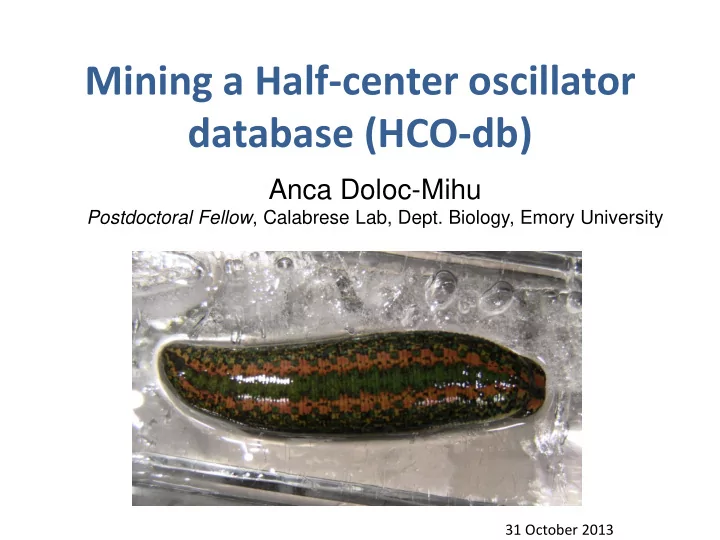

Mining a Half-center oscillator database (HCO-db) Anca Doloc-Mihu Postdoctoral Fellow , Calabrese Lab, Dept. Biology, Emory University 31 October 2013
Target? • Understanding how a basic network system produces functional activity under different parameter regimes • Understanding how different parameter regimes influence stability
Some biology… Computational neuroscience is the study of brain function in terms of the information processing properties of the structures that make up the nervous system. It is an interdisciplinary science that links the diverse fields of neuroscience, cognitive science, and psychology with electrical engineering, computer science, mathematics, and physics [wikipedia]. Layer1 Central pattern generators Central Pattern Generator (CPG) (CPGs) are neural networks that produce rhythmic patterned outputs without sensory Layer2 feedback. Motor Neurons Rhythmic activity? Layer3 Muscle A biological neuron model (also known as spiking neuron model ) is a mathematical description of the properties of nerve cells, or neurons, that is designed to accurately describe and predict biological processes. This is in contrast to the artificial neuron, which aims for computational effectiveness, although these goals sometimes overlap.
Heartbeat system of leech The heartbeat system of the leech is a closed circulatory system composed of two lateral heart tubes. The heart motor neurons are controlled by rhythmic inhibitory input from a network of heart interneurons (HN) that compose the heartbeat central pattern generator (CPG).
Leech CPG The rhythmic activity of the heartbeat neuronal network of the leech is based on pairs of inhibitory interneurons that make reciprocal spike-mediated and graded synapses across the ganglionic midline.
Half-center oscillator model (HCO) We modeled a pair of HN(4) reci- procally inhibitory interneurons, using the half-center oscillator (HCO) model of Hill et al., J Comp. Neurosci 2001 . We investigated the changes in this model's oscillatory activity and bursting characteristics based on cellular and synaptic parameters. Model characteristics: => individual neurons represented as single isopotential compart- ments with Hodgkin and Huxley type membrane conductances. => differential equations are integrated with the exponential Euler method with a time step of s.
Parameters influence on bursting activity? Target: Find parameters and their potential relationships that produce and maintain functional activity in the HCO model Method: Parameter variation Current Description Min step Max canonical Eleak Reversal potential -70mV 5mV -50mV -60mV P Persistent Na+ 0% 25% 175% 7nS CaS Slow inactivating low-threshold Ca 0% 25% 175% 3.2nS h Hyperpolarization-activated cation 0% 25% 175% 4nS K2 Persistent K 0% 25% 175% 80nS leak Voltage independent 0% 25% 175% 8nS SynG Graded transmission 0% 25% 175% 30nS SynS Spike-mediated transmission 0% 25% 175% 60nS Parameter space of 10,485,760 simulated instances: • 10,321,920 HCOs • 163,840 isolated neurons
Example simulation Parameter varied Eleak = -65mV Period = the interval between the middle spikes of two consecutive bursts Duty cycle = the percentage of the period occupied by a burst
Extracting firing characteristics • Type of activity: silent, spiking, bursting • Then, from bursting models, collect characteristics: – Number of bursts, – Spike frequency (calculated min, max, std) – Mean, std and coefficient of variation of: period, phase, duty cycle, – Burst duration, – Etc.
Group Classification by Activity Type Classification Algorithm: • No positive misses, but allow for false negatives • First, we sampled 10,000 models to decide on the thresholds and steps of the algorithm • Java 1.5 scripts • => output is a unique label for each neuron, then a decision is made for the label of the entire model
Doloc-Mihu and Calabrese, J Biol Physics,2011 .
HCO-db database We stored: • the simulation files into an archive and • the varied parameter values and the characteristics of the simulated instances into a database (HCO-db).
HCO-db • an efficient relational MySQL database table (HCO-db) with the resulting HCO instances characteristics • automatically build using our Java 1.5 scripts – Advantages of using Java: platform-independent, does not require to load in memory the whole database for querying it (unlike Matlab) • the characteristics of each simulated instance were recorded into a row of the database • each model in the database has its own unique identifier (unique number which also is a primary key in the database), which makes it easier to query • in addition for efficient querying, we used another 13 indexes: for each parameter, for each neuron type, and for the system type (group label).
HCO-db (cont.) • we chose the optimal data type for each field in the database to minimize the storage space required and to speed up the querying process. For example, the parameter values weren't recorded as floating point values, but as small integers which gave the percents of the parameter values with respect to their canonical values. • we just recorded a pointer to the place in the archive where the simulation files reside (the name of the folder/subfolder for each model).
Activity and model parameters of ten simulated instances
Analyzing the HCO-db Visualizations: NDVis , plots,… Here and next slide, NDVis view of HCO- db data
Analyzing the HCO-db (cont.) • 3D Matlab plot of set of neurons
Principal Component Analysis (PCA) Realistic regular bursting isolated neuron instances 5D clickable view
Principal Component Analysis (PCA) Realistic HCO instances 5D clickable view
More info… • http://www.biology.emory.edu/research/Calabrese/hco- db/hcoDB_Main.html • HCO-db paper: – A. Doloc-Mihu and R. L. Calabrese, A database of computational models of a half-center oscillator for analyzing how neuronal parameters influence network activity , J. Biological Physics 37:263-283, 2011. [PubMed: PMC3101324]. Thank you! and Good Luck!
Recommend
More recommend